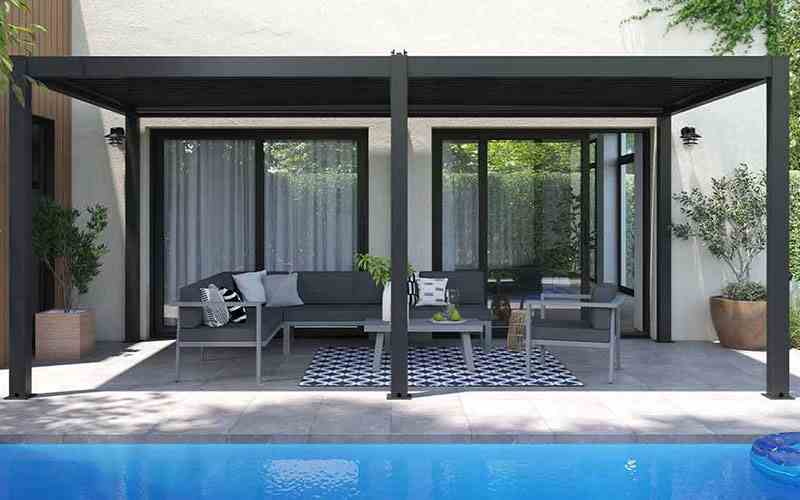What is a bioclimatic pergola?
A traditional pergola is a kind of arbor that is often installed as an extension of the home. It can be used to accommodate climbing plants. It is possible to settle down below to take advantage of its shade. For its part, the bioclimatic pergola is inspired by the framework of the traditional pergola. It offers the same advantages, but its design is more thought out for a year-round use and comfort.
Insofar as its location is permanent, its position in relation to the dwelling must be considered. It will protect you against the vagaries of the weather, such as rain, wind, etc., and, conversely, in such a way as to allow you to exploit pleasant natural resources, such as light, etc. In addition, know that a large number of them are also designed to accommodate gutters to collect rainwater.
Define your project
Your project will depend on different constraints:
- The law: if the pergola has an area between 5 and 20 m², it is, under the terms of the law, considered as a new construction. This means that depending on the size of pergola you choose, install permissions will first be necessary.
- The space you have.
- The covered space you will need depending on the number of people to accommodate and what you want to be able to do there.
- The type you want: attached or self-supporting pergola.
- A backed pergola is attached directly to the wall and is held to the ground by 2 feet.
- A self-supporting pergola is fixed to the ground by four legs. Because of this independence, it can be installed anywhere.
- Your budget
Where to place your pergola?
Not only is a pergola very useful, but it also brings an aesthetic touch to your exterior. Nevertheless, its location must be chosen with care to meet your needs.
- For example, if you want to create an extension of your living room, it is important to install it in front of this room or as close as possible to it to give the impression of extending it.
- Your goal may also be to shade a corner of your patio. You must therefore choose the location according to the exposure.
- For an extended life of your pergola, you should also remember to install it sheltered from strong winds.
- Finally, the major criterion that will determine the location of your pergola is the space you have.
- If the surface of your exterior is limited, choose a lean-to pergola that takes up less space.
- Conversely, if the surface of your exterior is larger, you can opt for a freestanding pergola.
What permits are required for a bioclimatic pergola?

As we have seen, the installation of a pergola, whether attached or freestanding, is governed by law, but depending on its size, the rules are not the same.
For a pergola of less than 5 m²
If the pergola you want to install measures less than 5m², no permission is needed.
For a pergola between 5 and 20 m²
For a bioclimatic pergola with a ground surface between 5 and 20 m², a prior declaration of work at the town hall is mandatory. The town hall will notify you of its acceptance by issuing you a town planning certificate.
For a pergola of more than 20 m²
For a bioclimatic pergola with a ground surface greater than 20 m², you must apply for a building permit at the town hall.
Good to know
If you live in a municipality subject to the PLU or Local Urbanism Plan, the 20 m² threshold is increased to 40 m² according to article R.421-17 of the Urban Planning Code. If in doubt, it is always easier to get closer to your town hall, which can advise you more precisely depending on your situation.
Why and when to declare a pergola?
As we mentioned earlier, a pergola of more than 5 m² is, legally speaking, considered as a new construction, but the law requires that new constructions be declared. This is the reason why you should not, under any circumstances, neglect to declare the construction of your pergola to your town hall, which it is recommended to do as soon as you have made your choice and determined the different elements of your project.
If you do not take these steps upstream, you expose yourself to fine of up to €300,000 in addition to the obligation to uninstall your pergola.

